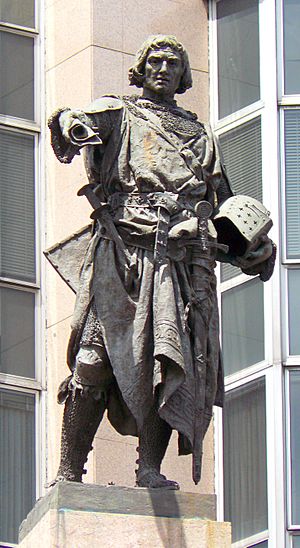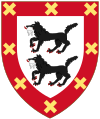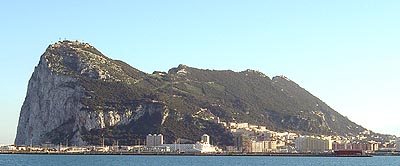Diego López V de Haro facts for kids
Quick facts for kids
Diego López V de Haro
|
|
|---|---|

Statue of Diego Lopez V by Mariano Benlliure.
|
|
| Lord of Biscay | |
| Coat of arms |  |
| Reign | 1295–1310 |
| Predecessor | Henry of Castile |
| Successor | María II Díaz de Haro |
| Born | c. 1250 |
| Died | January 1310 Algeciras |
| Buried | Monasterio de San Francisco, Burgos |
| Noble family | Haro |
| Spouse(s) | Violant of Castile |
| Issue among others... |
Lope Díaz IV de Haro Fernando Díaz de Haro |
| Father | Diego López III de Haro |
| Mother | Constanza de Bearne |
Diego López V de Haro, also known as el Intruso (meaning "the Intruder"), was an important Spanish noble. He lived from around 1250 to 1310. He belonged to the House of Haro and became the Lord of Biscay. He took this title from John of Castile, who also wanted to be Lord.
Diego López V also served as the King's Chief Steward (Mayordomo mayor del rey) and Royal Standard Bearer (Alférez del rey) for King Ferdinand IV of Castile. He did a lot for the city of Bilbao. He helped the local fishing village grow and gave it special rights. These rights allowed Bilbao to have its own market without paying royal taxes (called Portazgo). This meant the town only answered to the Lord of Biscay.
Contents
Family Background
Diego López V was the son of Diego López III de Haro and his wife, Constanza de Bearne. He became the Lord of Biscay after his father. His sister and John of Castile had also claimed the title.
His grandparents on his father's side were Lope Díaz II de Haro, who was also Lord of Biscay, and Urraca Alfonso de León. Urraca was the daughter of King Alfonso IX of León. His grandparents on his mother's side were Guillermo II de Bearne and Garsenda of Provence.
Diego López V had several siblings, including Lope Díaz III de Haro and Teresa de Haro. Teresa was married to Juan Núñez I de Lara, a powerful noble.
Life Story
Becoming Lord of Biscay (1295–1301)
Diego López V was likely born around 1250. In 1282, he married Violant of Castile, who was the daughter of King Alfonso X of Castile.
After King Sancho IV of Castile died on April 25, 1295, there was a lot of trouble in the kingdom. King Ferdinand IV of Castile was very young. Diego López V used this chance to take control of the Lordship of Biscay. This land actually belonged to his niece, María II Díaz de Haro.
During this time, many powerful nobles were fighting for control. John of Castile wanted to be king. Infante Henry of Castile wanted to be the young king's guardian. Other nobles, like Diego López V, also caused problems.
In the summer of 1295, a big meeting called the Cortes of Valladolid happened. At this meeting, Diego López was allowed to keep Biscay. This was agreed upon by John of Castile, who also temporarily accepted Ferdinand IV as king.
A very important event happened on June 15, 1300. Diego López V de Haro officially made the fishing village of Bilbao into a town. This new town was under the authority of the Lords of Biscay.
Later in 1300, John of Castile gave up his claim to the throne. He promised to be loyal to King Ferdinand IV. At the same time, María II Díaz de Haro and her husband (the same John of Castile) received other lands as a trade-off for giving up their claim to Biscay.
Political Struggles (1301–1310)
In November 1301, the Pope officially approved the marriage of King Ferdinand IV's parents. This made Ferdinand IV's claim to the throne much stronger. This upset some nobles, like Infante Henry of Castile and John of Castile, who had hoped to gain more power.
The kingdom was divided into two main groups. One group included Infante Henry of Castile, Queen María de Molina (Ferdinand IV's mother), and Diego López V. The other group had John of Castile and Juan Núñez II de Lara. These groups often argued and threatened war.
In 1303, there was a plan to split the kingdoms of Castile and León and make King Ferdinand IV step down. Queen Maria de Molina refused to support this plan. She convinced many nobles to stay loyal to the king. This helped to calm some of the fighting.
When Infante Henry of Castile died in 1303, Diego López V and another noble, Juan Manuel, Prince of Villena, inherited his lands. This made them even more powerful.
In 1304, John of Castile again demanded that his wife, María II Díaz de Haro, get back the Lordship of Biscay. King Ferdinand IV tried to make a deal. He offered Diego López V other lands in exchange for Biscay. But Diego López V refused and threatened to rebel.
Fighting Over Biscay (1305–1307)
In 1305, Diego López V was called to a meeting to discuss the demands for Biscay. His niece, María II Díaz de Haro, asked for her land back. Diego López V arrived with 300 knights and refused to give up his title. He said his niece had given up her claim in 1300. Diego López V then left the meeting and tried to get help from the Pope.
Diego López V formed a new alliance with Juan Núñez II de Lara. King Ferdinand IV tried to break this alliance, but he failed.
In 1306, King Ferdinand IV declared war on Juan Núñez II de Lara. Diego López V supported his ally. The king's forces tried to capture Juan Núñez, but he escaped. Juan Núñez, Diego López, and his son, Lope Díaz IV de Haro, promised to fight the king.
Because the war was expensive and many nobles did not support it, the king asked Queen María de Molina to negotiate peace. Negotiations with Diego López V failed, and he again appealed to the Pope.
In early 1307, the Pope said that the 1300 agreement about Biscay was not valid. This meant Maria II of Haro's claim was strong again. A new agreement was made: Diego López V would keep Biscay for his lifetime. After he died, it would go to María II Díaz de Haro, not to Diego's son, Lope Díaz IV. Lope would instead inherit other lands like Orduña-Urduña and Balmaseda.
With this agreement, Diego López V and John of Castile became allies with the king again.
The Siege of Algeciras (1309)

In 1309, King Ferdinand IV decided to attack the Muslim kingdom of Granada. Many important nobles, including Diego López V de Haro, John of Castile, and Juan Núñez II de Lara, joined the king. They also had soldiers from many Spanish cities and knights from Portugal. The Pope even gave the king money from church taxes to help fund the war.
King Ferdinand IV decided to lay siege to Algeciras, a major Muslim stronghold. Diego López V and others wanted to attack Gibraltar instead, but the king chose Algeciras.
The Christian army arrived at Algeciras in July 1309. While the siege of Algeciras was happening, Gibraltar was captured by King Ferdinand's forces on September 12, 1309.
In October 1309, some nobles, including John of Castile, left the siege because the king owed them money. But King Ferdinand IV still had the support of Juan Núñez II de Lara and Diego López V de Haro. They continued trying to take Algeciras.
Conditions in the army camp became very bad due to sickness. King Ferdinand IV even had to pawn his wife's jewels to pay his soldiers.
Towards the end of 1309, Diego López V became very ill with gout. He died in the Christian camp near Algeciras in January 1310. After many months, King Ferdinand IV made a peace deal with Granada. He lifted the siege in exchange for money and some towns.
Death and Legacy
Diego López V de Haro died in early 1310 during the siege of Algeciras. After his death, his niece, María II Díaz de Haro, became the new Lord of Biscay.
Diego López V's body was taken to Burgos. He was buried at the Monasterio de San Francisco, a monastery that no longer exists. His wife, Violant of Castile, was also buried there.
Marriage and Children
Diego López V de Haro married Violante of Castile. They had the following children:
- Lope Díaz IV de Haro (1285–1322). He was Lord of Orduña and Balmaseda. He died without having any children.
- Fernando Díaz de Haro. He became Lord of Orduña and Valmaseda after his brother Lope died. In 1315, he married Maria of Portugal, Lady of Meneses and Orduña.
- Pedro López de Haro. He died when he was a baby.
- María Díaz de Haro. She was Lady of Tordehumos. She married Juan Núñez II de Lara, who was Lord of Lara.
See also
 In Spanish: Diego López V de Haro para niños
In Spanish: Diego López V de Haro para niños

